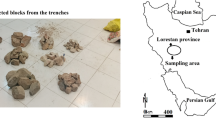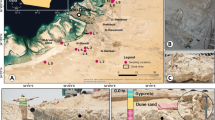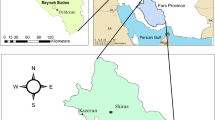Abstract
Texture and grain size is of great importance in understanding the mechanical properties of rocks. The aim of this study was to investigate textural and slaking durability characteristics, and correlate them with the gypsum types where the dolines occurred, with particular reference to the texture and crystal size. The investigation comprised two stages: field work and laboratory testing. Initially, rock samples were obtained from various representative karstified and non-karstified locations. Thereafter, mineralogical, physical and slaking durability characteristics of the gypsum samples were determined by means of laboratory testing. After the field and laboratory works, the geological, mineralogical and slaking durability characteristics of the study area gypsum were reviewed and discussed from the point of view of doline formation. Results showed that fine grain sized alabastrine gypsum tends to be karstified and leads to doline formation. This is closely related to the crystal size, texture and attributable to the slaking durability of the gypsum. Consequently, the results demonstrate that the texture, especially crystal size, and effective porosity are important parameters controlling the slake durability of the gypsum and doline formation.










Similar content being viewed by others
References
Anon (1979) Classification of rocks and soils for engineering geological map** part 1: Rock and soil materials. Bull Int Assoc Eng Geol 19:355–371
ASTM (1990) Standard test method for slake durability of shalesand similar weak rocks (D4644). Annual Book of ASTM Standards, vol 4.08. ASTM, Philadelphia, pp 863–865
Benavente D, Garcia del Cura MA, Fort R, Ordonez S (2004) Durability estimation of porous building stones from pore structure and strength. Eng Geol 74:113–127
Brown ET (ed) (1981) Rock characterization, testing and monitoring (ISRM suggested methods). Pergamon, UK, p 211
Ceyhan F (1987) Geology, formation, source and economic properties of the salt and gypsum in the southeast of Sivas (in Turkish with English abstract). MSc Thesis, Cumhuriyet University, p 107
Deer WA, Howıe RA, Zussman J (1962) Rock forming minerals. Non-silicates, vol 5. Longmans, London
Dhakal G, Yoneda T, Kato M, Kaneko K (2002) Slake durability and mineralogical properties of some pyroclastic and sedimentary rocks. Eng Geol 65:31–45
Dick JC, Shakoor A (1995) Characterizing durability of mudrocks for slope stability purposes. Geol Soc Am Rev Eng Geol X:121–130
Dreiss SJ (1984) Effects of lithology on solution development in carbonate aquifers. J Hydrol 70:295–308
Dullien FAL (1992) Porous media fluid transport and pore structure. Academic, San Diego
Ford DC, Williams PW (1989) Karst geomorphology and hydrology. Unwin Hyman, UK, p 601
Franklin JA, Chandra A (1972) The slake durability test. Int J Rock Mech Min Sci Geomech Abstr 9:325–341
Gokceoglu C, Ulusay R, Sonmez H (2000) Factors affecting durability of selected weak and clay bearing rocks from Turkey, with particular emphasis on the influence of the number of drying and wetting cycles. Eng Geol 57(3–4):215–237
Gregg SJ, Sing KSW (1982) Adsorption, surface area, and porosity, 2nd edn. Academic, London
ISRM (1981) Suggested methods for determining hardness and abrasiveness of rocks, part 3. Commission on standardisation of laboratory and field tests, pp 101–102
Karacan E, Yılmaz I (1997) Collapse dolines in the Miocene gypsum: an example from SW Sivas (Turkey). Environ Geol 29(3–4):263–266
Karacan E, Yılmaz I (2000) Geotechnical evaluation of Miocene gypsum from Sivas (Turkey). Geotech Geol Eng 18(2):79–90
Kurtman F (1973) Sivas-Hafik-Zara ve İmranlı bölgesinin jeolojik ve tektonik yapısı (in Turkish). M.T.A. Dergisi 80:1–32
Rodrigues JD (1991) Physical characterization and assessment of rock durability through index properties. NATO ASI Ser E Appl Sci 200:7–34
Tiab D, Donaldson EC (1996) Petrophysics: theory and practice of measuring reservoir rock and fluid transport properties. Gulf Publishing, Houton
Acknowledgements
Authors are deeply grateful to Prof. Jan VLCKO (Comenius University, Slovakia) for his careful review and helpful comments on the manuscript.
Author information
Authors and Affiliations
Corresponding author
Rights and permissions
About this article
Cite this article
Yilmaz, I., Karacan, E. Slaking durability and its effect on the doline formation in the gypsum. Environ Geol 47, 1010–1016 (2005). https://doi.org/10.1007/s00254-005-1234-1
Received:
Accepted:
Published:
Issue Date:
DOI: https://doi.org/10.1007/s00254-005-1234-1




